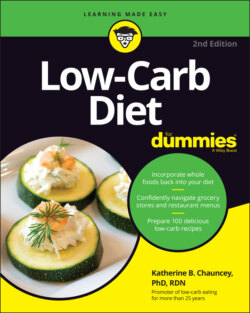Читать книгу Low-Carb Diet For Dummies - Katherine B. Chauncey - Страница 75
Replacing the Food Pyramid with a Healthy Eating Plate
ОглавлениеEven though the Food Guide Pyramid was around for many years and increased nutrition knowledge in the United States, it did little to change the eating habits of consumers. The Food Guide Pyramid emphasized lowering fat in the diet and replacing it with bread, cereals, grains, fruits, and vegetables. Fat is a calorie-dense fuel and provides 9 calories per gram, whereas carbohydrate and protein each supply 4 calories per gram.
Current wisdom would say if you cut out something that gives 9 calories and replace it with something that gives 4 calories, you’d reduce your total calorie intake. Sounds reasonable, right? Take away high-fat foods and replace them with fruits, vegetables, and whole grains, but that’s not what happened.
Unfortunately, along with the reduced-fat message came fat-free cookies, cakes, chips, snacks, and desserts that displaced the intended healthier choices of fruits, veggies, and whole grains. After all, fat tastes good, so to trick consumers’ taste buds into thinking that fat-free foods tasted good, manufacturers loaded the food with sugar. So, they didn’t just replace a fat gram with a carbohydrate gram in an even swap; they replaced the fat with double, triple, and quadruple the carbohydrate! Many consumers saw a box of fat-free cookies as a free food and ate the whole box rather than just a serving.
Scientists realized a change needed to happen to provide guidance to consumers to help them eat healthier. That’s how the Healthy Eating Plate came about. Designed by experts at Harvard School of Public Health and Harvard Medical School, the Healthy Eating Plate (see Figure 3-1) directs consumers to the healthiest choices in major food groups.
Copyright © 2011 Harvard University.
FIGURE 3-1: The Healthy Eating Plate.
For more information about The Healthy Eating Plate, see The Nutrition Source, Department of Nutrition, Harvard T.H. Chan School of Public Health, www.thenutritionsource.org and health.harvard.edu.
A number of research studies suggest that diets designed to lower the insulin response to ingested carbohydrate (such as a low-glycemic-index diet) may improve utilization of stored energy (body fat), decrease hunger, and promote weight loss. The Healthy Eating Plate demonstrates that such a diet would have as its base abundant quantities of low- to moderate-glycemic vegetables and fruits, moderate amounts of protein, legumes, reduced-fat dairy, and healthy fats (like olive and canola oil), and an emphasis of whole grains over refined-grain products, potatoes, french fries, and concentrated sugars. The Whole Foods Weight Loss Eating Plan closely approximates the recommendations of Harvard’s Healthy Eating Plate (refer to Chapter 2 for more about this plan).
